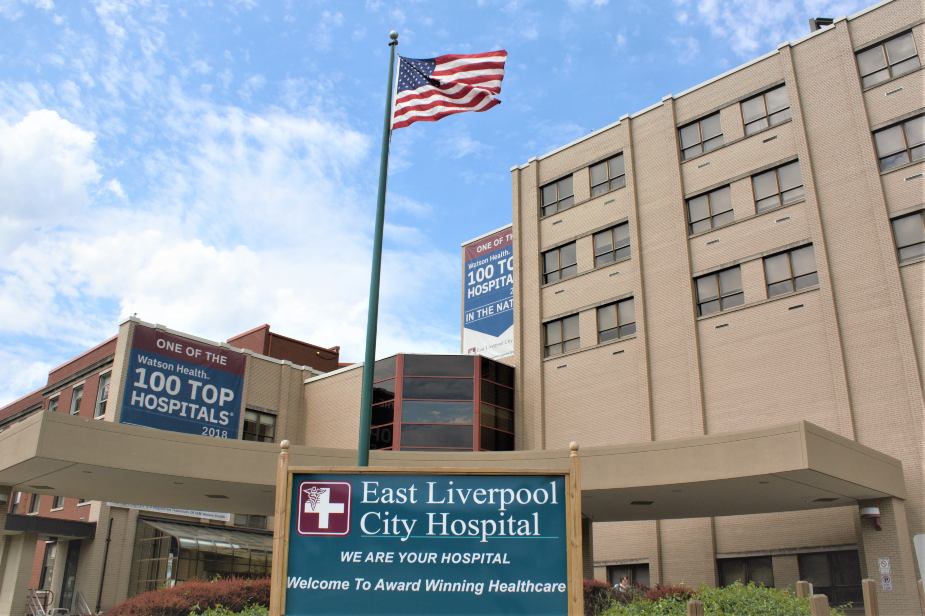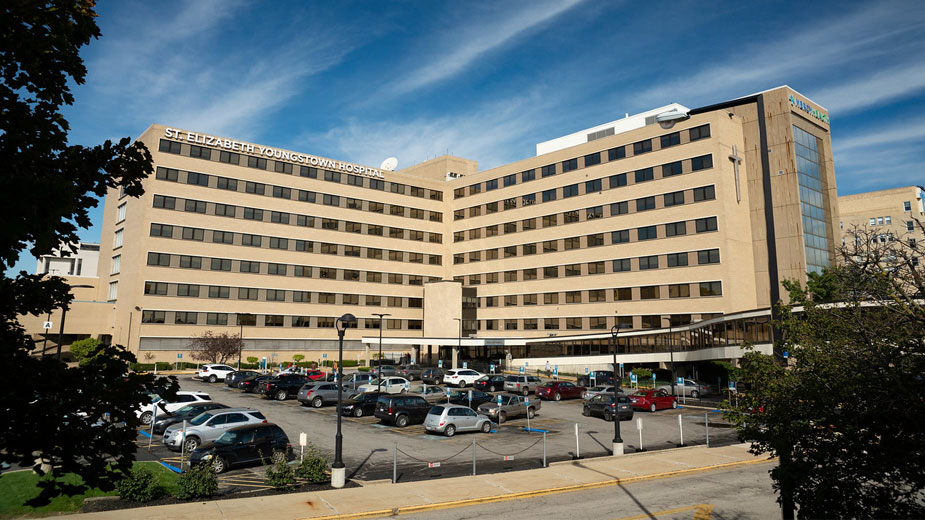Staffing, Vaccines are Key Concerns at Valley Hospitals Amid COVID Surge
YOUNGSTOWN, Ohio – With the Ohio Department of Health reporting a record 12,502 new COVID-19 cases on Dec. 21, hospitals in the Mahoning Valley are feeling the squeeze with the influx of infected patients.
“This is absolutely the busiest month we’ve had in 2021 for COVID at our three hospitals,” says Dr. James Kravec, chief clinical officer at Mercy Health-Youngstown, which operates St. Elizabeth Boardman, St. Elizabeth Youngstown and St. Joseph Warren hospitals.
The volume of COVID patients at those hospitals “has absolutely skyrocketed” over the last 60 days, Kravec says. On average, patients with COVID-19 account for 25% to 30% of the hospital system’s total patient population, which is up from as low as 3% in early summer.
That surge at Mercy hospitals, as well as its eight walk-in care locations in the region, is causing downstream effects, including longer emergency room waits and delays in ambulances being able to hand off patients and get back into the field, he says.
Another concern are the so-called “ER holds,” in which a patient is admitted to a hospital. But if no beds are available, that patient must remain in the ER until one is.
“Sometimes that could be a day or two,” Kravec says. “It’s true all over Ohio.”

Volume of patients and available staffing are the two variables that determine what those waits look like.
At East Liverpool City Hospital, both COVID and non-COVID patients are being held in the ER, but the hospital could put more patients in beds if there was staff to handle that capacity, says Dr. Gretchen Nickell, chief medical officer.
“We’re more limited by staff than we are beds, which appears to be similar among hospitals in the state,” Nickell says. “If we had additional staff, we’d be able to house more on the floors.”
Nickell estimates current staffing at East Liverpool City Hospital is down at least 10% from before COVID. Reasons for the hospital losing staff range from burn out and early retirement to individuals taking positions in nonclinical fields or some clinical workers, such as nurses, taking traveling positions.
However, losses in nonclinical departments affect treatment as well, she notes.
“Every department matters,” Nickell says. “Housekeeping is as important as other departments. As is dietary. As is accounting.”
Other workers are out themselves with COVID or other illnesses, she adds. The hospital has been seeing many patients with the flu, although those numbers “pale in comparison to what we’re seeing with COVID.
“We’ve been steadily trending upward since Thanksgiving, which is something that we expected with holiday gatherings,” Nickell says.
Demand for nurses is leading all other occupations in the state. Earlier this month, Ohio Means Jobs reported 14,254 job postings for registered nurses on the JobsOhio Network from Sept. 14 to Oct. 13.
On Dec. 17, Gov. Mike DeWine mobilized 1,050 members of the Ohio National Guard to help relieve the strain on understaffed hospitals amid increasing numbers of COVID-19 patients. Of those members mobilized, some 150 are “highly-trained medical professionals” who can help with critical needs at hospitals and testing locations, according to a press release. The remaining 900 will assist with patient transport, housekeeping and food services.
The Ohio Department of Health is also working with an Ohio health-care staffing company to further meet hospital staffing needs by bringing in qualified nurses and other providers from out-of-state to fill positions.
As of Dec. 21, Ohio hospitals had 4,797 patients hospitalized with COVID-19, according to Coronavirus.ohio.gov. That includes 1,206 in the intensive care unit and 769 on a ventilator.
Region 5, which includes Mahoning, Trumbull and Columbiana counties, reported 1,075 COVID-19 hospitalizations, with 252 in ICU and 185 on a ventilator.
Eye on Ohio reports 26% of all ICU patients have COVID – a new high since the pandemic began.
Of those hospitalized locally for COVID-19, the “vast majority” are unvaccinated – about 90% to 95%, Kravec says. Nearly 100% of those in the ICU in Mercy hospitals are unvaccinated.
Nickell sees similar numbers in East Liverpool. On average, COVID patients account for 20% to 30% of the hospital’s total population, but sometimes can go as high as 50%, she says. Of those patients, anywhere from 8% to 20% are vaccinated.
And while some who are vaccinated can still get a breakthrough case, “The unvaccinated have a more severe course,” Nickell says, sometimes requiring a stay of three to four weeks. With COVID restraints preventing hospitals from transitioning those patients to long-term care facilities if they need additional care, the stay can be even longer, tying up beds at the hospital.
Getting Shots in Arms
Health care providers and public health officials continue to promote the vaccine as an important layer in preventing serious illness and possibly death from COVID-19.
As of Dec. 21, of all vaccine-eligible Ohioans, 59.27% have started the vaccine series, according to Coronavirus.ohio.gov. On average, 56.45% of eligible recipients in Mahoning County have started their vaccinations, compared to 53.95% in Trumbull County and 46.14% in Columbiana County.
Statewide, 54.61% have completed the initial vaccine series.
Ohio health providers are pleading with residents to get vaccinated. This week, Cleveland Clinic, MetroHealth, University Hospitals, Summa Health, the U.S. Department of Veterans Affairs and St. Vincent Charity Medical Center took out a full-page ad in the Cleveland Plain Dealer with a one-word plea: Help.
Local hospitals and health departments have taken to social media and local news outlets to promote the vaccine, but some feel as if they’ve hit the ceiling on the number of people getting the shot.
“It seems as though we’ve accomplished as high of a percentage of vaccinated people as we’re going to get in this area,” Nickell says. “I don’t know that we’re going to see a lot more demand.”
And while hospitals and area vaccine clinics still see people coming in for booster shots, they haven’t seen much more for initial doses.
That’s disappointing, says Nickell, who sees vaccinated patients having milder symptoms when infected.
“It’s been a difficult thing to see so many people so sick for so long,” she says.
The Columbiana County General Health District has stopped using its drive-thru vaccination clinic at Columbiana County Fairgrounds for COVID boosters, says Laura Fauss, public information officer. The organization used half of the two-lane building twice for boosters, but didn’t get enough patients to justify having the number of staff required to run the clinic, she says.

“The drive-thru wasn’t near as busy as it was when we did it the first go around,” Fauss says.
The department has been conducting booster vaccinations at its office at 7360 State Route 45 in Lisbon, which Fauss says has seen increased demand. It also goes into schools to vaccinate teachers and staff, and goes into group homes.
Demand for testing remains strong. During the holidays, health districts are encouraging residents to use at-home rapid COVID tests before visiting indoors.
Columbiana County General Health District offers Binaxnow tests for free. Residents can call 330 424 0272 to reserve their tests and pick them up at the office.
Mahoning County Public Health distributed nearly 5,000 home tests last week and has more to pass out, says Commissioner Ryan Tekac.
This time last year was when vaccines were first coming available, so people were more cautious, Tekac says. This year will be different, as those who are vaccinated and boosted will make the decision to gather. He advises individuals to take into consideration who they are visiting – such as vulnerable populations and young children who aren’t yet eligible for vaccination – and to test before gathering.
Mahoning County vaccination numbers are dropping. Booster doses administered at the health department have gone from about 500 weekly to half that, Tekac says. First and second doses are about a dozen each week. The drop in numbers at the department’s office could be because there are more places now to get a vaccine, he allows.
Tekac is hopeful the current level of vaccination will prevent the case numbers seen a year and a half ago, he says.
“So when they do come down with the virus, it’s a mild case,” Tekac says.
Still, providers expect a surge after the Christmas and New Year’s holidays into the middle of January. To help curb increased demand at hospitals, they recommend patients go to a walk-in site for testing or minor illnesses rather than go to the ER.
“It’s important to not go to the ER if you don’t have to,” Kravec says. Click HERE for a list of Mercy walk-in clinics.
For now, Mercy hospitals aren’t foregoing certain procedures and surgeries, Kravec says. The system has daily conversations about staffing and patient volumes to find ways to open more beds when needed.
“If we do see more patients, we’ll do our best to take care of all of them,” he says.
East Liverpool City Hospital has halted some elective procedures based on staffing availability, Nickell says. For instance, if a surgery would require an overnight stay, it may be postponed “because we don’t have the overnight beds for that,” she says.
Salem Regional Medical Center is also postponing non-urgent surgeries and procedures to make additional inpatient beds available for the “unprecedented demand for inpatient care,” President and CEO Dr. Anita Hackstedde, said in a prepared statement. Essential surgeries and procedures will continue during this time, she said.
“We also appreciate your patience with our staff as there are many days when our hospital has been at full capacity. For almost two years, our physicians and staff have been faithfully fighting COVID-19 and we need your help,” Hackstedde said.
“We urge our communities to help prevent the spread of this virus and receive their COVID-19 vaccine, as the majority of our patients hospitalized with COVID-19 are unvaccinated. We need you to join with us in this fight, especially as we enter the next round in the face-off with the Omicron variant, which is already spreading within our region.”
Pictured at top: Mercy Health – St. Elizabeth Youngstown.
RELATED: Biden Pivots to Home Tests to Combat Omicron Surge
Copyright 2024 The Business Journal, Youngstown, Ohio.



